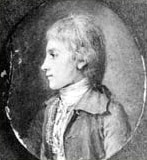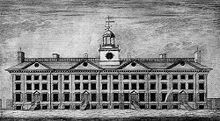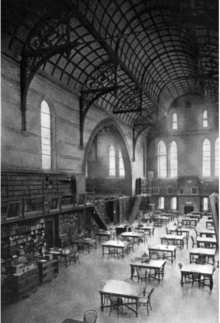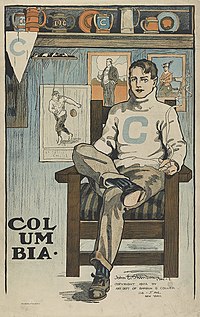History of Columbia University

The history of
Founding of King's College
The period leading up to the school's founding was marked by controversy, with various groups competing to determine its location and religious affiliation. Advocates of New York City met with success on the first point, while the Church of England prevailed on the latter. However, all constituencies agreed to commit themselves to principles of religious liberty in establishing the policies of the College.[1]
Although the
In 1746 an act was passed by the general assembly of New York to raise a sum of £2,250 by public lottery for the foundation of a new college, despite the fact that the University had neither a founding denomination nor a location for its first campus. In 1751, the assembly appointed a commission of ten New York residents, seven of whom were Church of England members, to direct the funds accrued by the state lottery towards the foundation of a college.
King's College (1754–1784)

- Includes the administrations of Samuel Johnson (1754–1763) and Myles Cooper(1763–1785)
Classes were initially held in July 1754, the delay stemming from the inability of the college to secure adequate faculty. Dr. Johnson was the only instructor of the college's first class, which consisted of a mere eight students. Instruction was held in a new schoolhouse adjoining Trinity Church, located on what is now lower Broadway in Manhattan.[13] The college was officially founded on October 31, 1754, as King's College by royal charter of King George II, making it the oldest institution of higher learning in the state of New York and the fifth oldest in the United States.[1] On June 3 of the following year, the Governors of the College adopted a design prepared by Dr. Johnson for the seal of King's College, which continues to be that of Columbia College with the alteration in name.[14] In 1760, King's College moved to its own building at Park Place, near the present City Hall, and in 1767 it established the first American medical school to grant the M.D. degree.[1]
Controversy surrounded the founding of the new college in New York, as it was a thoroughly Church of England institution dominated by the influence of

In 1763, Dr. Johnson was succeeded in the presidency by
The
Post Revolutionary War Recovery (1784–1800)
Columbia College under the Regents (1784-1787)

King's College had been in a state of abeyance for eight years by the time the war ended, with many of the members of the college's Board of Governors either absent or killed during the revolution. The college turned to the
On May 5, 1784, the Regents held their first meeting, instructing Treasurer
During the period under the Regents, many efforts were made to put the University on respectable footing, resolving to organize the college into the four faculties of Arts, Divinity, Medicine, and Law. A number of different professorships were created within each faculty, while the college remained under the supervision of the Regents. The staff of the entire university - which included numerous aforementioned professors, a president, a secretary, and a librarian – operated under the yearly budget of £1,200.[22] During this period no president was able to be appointed due to the college's inadequate funds, which rendered it unable to offer a salary as would induce a suitable person to accept the office. Instead, the duties of the president's office were held by the schools various professors, which led to discord between the school's faculty members. The Regents finally became aware of the college's defective constitution in February 1787 and appointed a revision committee, which was headed by John Jay and Alexander Hamilton. In April of that same year, a new charter was adopted for the college, still in use today, granting power to a private board of twenty-four Trustees.[23]
Columbia College as independent entity

On May 21, 1787,
During the period of Johnson's presidency, the College's campus began to expand, and in 1792 a new library extension was built to accommodate the College's growing library with the help of a grant from the Legislature of New York State. In December 1793, the Professorship of Law was filled by the election of James Kent, who gave the first instruction of law at any American University and was a forerunner to the University's Law School.[26] On July 16, 1800, the seventy-four-year-old Dr. Johnson resigned his presidency of the College.[27] In 1801, the Board of Trustees appointed Charles Henry Wharton as Dr. Johnson's successor. Wharton was to assume the office of president at the August commencement ceremonies, but he did not appear for them, and resigned in the fall.[28]
College stagnation (1800–1857)
Despite the College's liberal acceptance of various religious and ethnic groups, during the period from 1785–1849 the institutional life of the college was a continuous struggle for existence, owing to inadequate means and lack of financial support.[26][29]
The curriculum of the college during the beginning of the 19th century was mostly focused on study of the classics. As a result, the major prerequisite for admission into the College was familiarity with Greek and Latin and a basic understanding of mathematics. In 1810, following the advice of a committee put together by members of the school, the College greatly tightened its admission standards; nonetheless, admission of qualified students increased, with 135 students matriculating in 1810.[30] In the preceding decade, the average size of the graduating class had been seventeen.[31]
Because the school had no athletic program, student life during this period was mainly focused around literary groups such as the Philolexian Society, which was founded in 1802. In 1811, the College's new president William Harris presided over what became known as the ""Riotous Commencement" in which students violently protested the faculty's decision not to confer a degree upon John Stevenson, who had inserted objectionable words into his commencement speech.[32]
The main building which housed the College was decayed and unsightly in appearance; however, the funds of the College were augmented somewhat by the growing importance of its investments in real estate, although the true value of some of these acquisitions would not come to light until over a century later. For example, in 1814 the New York Legislature responded to the College's appeal for financial assistance by giving the school the Elgin Botanic Garden, a twenty-acre tract of land that had been privately developed as the nation's first botanical garden by physician David Hosack, but which Hosack had closed and resold to the state at a loss.[33] The site, which had been 3+1⁄2 miles (5.6 km) outside of the city limits in 1801, was leased by Columbia to John D. Rockefeller Jr. in the 1920s for the construction of Rockefeller Center.[34][35] It was still owned by Columbia until 1985, when it was sold for $400 million.[36]
In November 1813, the College agreed to combine its medical school with The College of Physicians and Surgeons, a new school created by the Regents of New York, forming Columbia University College of Physicians and Surgeons. During the 1820s, the College renovated its campus and continued to seek grants from the state while it slowly expanded the scope of its academic catalog, adding Italian courses in 1825.[37]
The College's enrollment, structure, and academics stagnated for the remaining forty years, with many of the college presidents doing little to change the way that the College functioned. Adding to the woes of the College during this period, in 1831 the school began to face direct competition in the form of the University of the City of New York, which was later to become New York University. This new university had a more utilitarian curriculum, which stood in contrast to Columbia's focus on ancient literature. As a demonstration of NYU's popularity, by the second year of its operation it had 158 students, whereas Columbia College, eighty years after its founding, only had 120. Trustees of Columbia attempted to block the founding of NYU, issuing pamphlets to dissuade the Legislature from opening another university while Columbia continued to struggle financially.[38] By July, 1854 the Christian Examiner of Boston, in an article entitled "The Recent Difficulties at Columbia College", noted that the school was "good in classics" yet "weak in sciences", and had "very few distinguished graduates".[39]
When
Expansion and Madison Avenue campus (1857–1896)

In 1857, the College moved from Park Place to a primarily
The transition to the new campus coincided with a new outlook for the college; during the 1857 commencement, College President
Among the new buildings constructed in this location, were Hamilton Hall (1879) as well as buildings for the School of Mines (1880-1884) and a combined building for the Library and the Law School.[45]
This period also witnessed the inauguration of Columbia's participation in intercollegiate sports, with the creation of the
Morningside Heights (1896–Present)

In 1896, the trustees officially authorized the use of yet another new name, Columbia University, and today the institution is officially known as "Columbia University in the City of New York." Additionally, the engineering school was renamed the "School of Mines, Engineering and Chemistry." At the same time, university president Seth Low moved the campus again, from 49th Street to its present location, a more spacious (and, at the time, more rural) campus in the developing neighborhood of Morningside Heights. The site was formerly occupied by the Bloomingdale Insane Asylum. One of the asylum's buildings, the warden's cottage (later known as East Hall and Buell Hall), still stands today.[47]
The building often depicted as emblematic of Columbia is the centerpiece of the Morningside Heights campus, Low Memorial Library. Constructed in 1895, the building is still referred to as "Low Library" although it has not functioned as a library since 1934. It currently houses the offices of the President, Provost, the Visitor's Center, and the Trustees' Room and Columbia Security. Patterned loosely on the Classical Pantheon, it is surmounted by the largest all-granite dome in the United States.[48]
Under the leadership of Low's successor,

In 1893 the
In 1904 Columbia organized adult education classes into a formal program called Extension Teaching (later renamed University Extension). Courses in Extension Teaching eventually give rise to the Columbia Writing Program, the Columbia Business School, and the School of Dentistry.[51]
In 1928, Seth Low Junior College was established by Columbia University in order to mitigate the number of Jewish applicants to Columbia College.[52][53] The college was closed in 1938 due to the adverse effects of the Great Depression and its students were subsequently taught at Mornington Heights, although they did not belong to any college but to the university at large.[54]
There was an evening school called University Extension, which taught night classes, for a fee, to anyone willing to attend. In 1947, the program was reorganized as an undergraduate college and designated the
By the late 1930s, a Columbia student could study with the likes of
Research into the atom by faculty members
During World War II, Columbia, Morningside Heights campus, was one of 131 colleges and universities nationally that took part in the V-12 Navy College Training Program which offered students a path to a Navy commission.[64]
During the 1960s Columbia experienced large-scale student activism centering over the Vietnam War and the demand for greater
Columbia College first admitted women in the fall of 1983, after a decade of failed negotiations with Barnard College, an all female institution affiliated with the University, to merge the two schools. Barnard College still remains affiliated with Columbia, and all Barnard graduates are issued diplomas authorized by both Columbia University and Barnard College.[67]
During the late 20th century, the University underwent significant academic, structural, and administrative changes as it developed into a major research university. For much of the 19th century, the University consisted of decentralized and separate faculties specializing in Political Science, Philosophy, and Pure Science. In 1979, these faculties were merged into the
In 1997, the Columbia Engineering School was renamed the
See also
- Columbia College of Columbia University, the oldest liberal arts undergraduate college at Columbia University, New York
- Columbia Daily Spectator, a student newspaper at Columbia University, New York
- Columbia Journal, the graduate writing program's student-founded, student-run literary journal Columbia University School of the Arts
- Columbia Journalism Review, a bimonthly journal published by the Columbia University Graduate School of Journalism
- Columbia Law School
- Columbia Business Law Review, a monthly journal published by students at Columbia Law School
- The Pulitzer Prize
- The School at Columbia University, New York City
- Teachers College, Columbia University's Graduate School of Education
References
Citations
- ^ a b c d e "A Brief History of Columbia". Columbia University. 2011. Archived from the original on 2018-01-06. Retrieved 2011-04-14.
- ^ Moore 1846, pp. 6–7.
- ^ McCaughey 2003, p. 1.
- ^ Schwickerath, Robert (1903). Jesuit Education: Its History and Principles Viewed in the Light of Modern Education Problems. p. 202.
- JSTOR 44208940.
- JSTOR 30079857.
- ^ Matthews 1904, pp. 8–10.
- ^ McCaughey 2003, p. 8.
- ^ Keppel, Fredrick Paul (1914). Columbia. Oxford, England: Oxford University Press. p. 26.
- ^ "2. Where the Money Came From". Columbia University and Slavery. Columbia University. Archived from the original on 13 October 2020. Retrieved 8 October 2020.
Merchants, including "the wealthiest and most important men of their time" considerably outnumbered lawyers, ministers, and others on the board of governors. They donated generously to the College. The initial list of 66 "subscribers," who donated a total of over 5,000 pounds to help launch King's, included Atlantic slave traders John Watts, Nathaniel Marston, Adoniah Schuyler, and John Cruger, and many others engaged in commerce with the Caribbean. Apart from Governor Charles Hardy, who gave 500 pounds, the largest contribution, 200, came from Marston, one of the city's merchants most actively involved in the slave trade from Africa. Most of the donors had a connection to slavery either via ownership or trade.
- ISBN 0-231-03942-5.
- ^ Matthews 1904, p. 2.
- ^ a b Butler 1912, p. 3.
- ^ Matthews 1904, p. 19.
- ^ McCaughey, Robert A. (September 15, 2004). "Farewell, Aristocracy – The World Turned Upside Down". Social History of Columbia University Fall 2004 Lectures. Archived from the original on September 9, 2006. Retrieved 2006-08-10.
- ISBN 978-1-59420-009-0.
- ISBN 978-0-8027-1374-2.
- ISBN 978-0-7432-2671-4.
- ^ Matthews 1904, p. 18.
- ^ Matthews 1904, p. 59.
- ^ ISBN 1-4021-3737-0 – via Internet Archive.
- ^ Matthews 1904, pp. 60–64.
- ^ Moore 1846, pp. 65–70.
- ^ Groce, C. G. (1937). William Samuel Johnson: A Maker of the Constitution. New York, New York: Columbia University Press.
- ^ Matthews 1904, p. 74.
- ^ a b Butler 1912, p. 5.
- ^ Moore 1846, p. 75.
- ^ McCaughey 2003, p. 65.
- ^ McCaughey 2003, p. 86.
- ^ Moore 1846, pp. 50–53.
- ^ Matthews 1904, pp. 86–96.
- ^ "Columbia's 1811 Graduation Ceremony Is Known as "The Riotous Commencement"". Columbia College Today. 2020-07-01. Retrieved 2024-04-22.
- ^ Okrent 2003, p. 21.
- ^ Okrent 2003, p. 106.
- ^ Matthews 1904, pp. 90–100.
- ^ Dowd, Maureen (February 6, 1985). "Columbia Is to Get $400 Million in Rockefeller Center Land Sale". The New York Times. Archived from the original on December 4, 2017. Retrieved January 28, 2018.
- ^ Moore 1846, pp. 53–60.
- ^ McCaughey 2003, pp. 87–89.
- ^ a b McCaughey 2003, Appendix E: Institutional Comparisons.
- ^ Columbia University, Addresses at the Inauguration of Mr. Charles King (1848), Ch. 4, pp. 3–53
- ^ Butler 1912, pp. 5–8.
- ISBN 978-0-231-07851-1.
- ISBN 978-0-231-07851-1.
- ^ McCaughey 2003, Leading American University Producers of PhDs, 1861–1900.
- ISBN 978-0-231-07851-1.
- ^ "Columbia College Student Life Timeline". Archived from the original on 2011-07-16. Retrieved 2011-04-16.
- ^ ""Columbia University's Lunatic Past." Ephemeral New York website. May 5, 2008". 5 May 2008. Archived from the original on January 15, 2021. Retrieved April 16, 2011.
- ^ "Low Memorial Library". 2002-07-30. Archived from the original on 2006-06-27. Retrieved 2006-08-10.
- ^ "About the School". Columbia University School of Journalism. Archived from the original on 2010-12-16. Retrieved 2011-04-15.
- ^ Andie Tucher. "Joseph Pulitzer's Mission". Columbia University School of Journalism. Archived from the original on 2010-12-01. Retrieved 2011-04-15.
- ^ "About Columbia Business School". Columbia University. Archived from the original on 2011-03-10. Retrieved 2011-04-16.
- ^ McCaughey 2003, p. 271.
- ^ "Columbia Daily Spectator 3 April 1928 — Columbia Spectator". Archived from the original on 24 April 2016. Retrieved November 24, 2016.
- ^ Asimov, I. (1979) In Memory Yet Green, Avon Books, pp. 157, 159–160, 240
- ^ "School of General Studies: History". Columbia School of General Studies. Archived from the original on July 19, 2011. Retrieved June 10, 2011.
- ^ "What makes GS different from Columbia's traditional undergraduate colleges? | General Studies". Archived from the original on 2016-11-23. Retrieved 2016-11-22.
- ^ "University Senate". Archived from the original on 2017-02-13. Retrieved 2016-11-22.
- ^ "The School Our History | Columbia University School of Professional Studies". Sps.columbia.edu. Archived from the original on 2016-11-22. Retrieved 2022-02-15.
- ISBN 978-1-57003-679-8.
- ^ "Attorney General Biographies: Harlan Fiske Stone". United States Department of Justice. Archived from the original on 2011-02-11. Retrieved 2011-04-16.
- ^ "Biography: Dwight David Eisenhower". Eisenhower Foundation. Archived from the original on 2008-05-23. Retrieved 2011-04-16.
- ^ Broad, William J. (2007-10-30). "Why They Called It the Manhattan Project". The New York Times. Archived from the original on 2020-07-07. Retrieved 2007-10-30.
- ^ "About SIPA: Growth and Tradition". Columbia University School of International and Public Affairs. 2006. Archived from the original on 2011-04-19. Retrieved 2011-04-16.
- ^ "World War II Wartime Efforts". New York City: Columbia University. 2011. Archived from the original on June 29, 2010. Retrieved September 25, 2011.
- ISBN 0-345-45582-7.
- ISBN 978-0-252-03452-7.
- ^ Link text. Archived 2010-12-13 at the Wayback Machine
- ^ "GSAS at a Glance | Columbia University | Graduate School of Arts and Sciences". Archived from the original on 2016-11-20. Retrieved 2016-11-24.
- ^ "History of the Faculty of Arts and Sciences | Faculty of Arts and Sciences". Archived from the original on 2016-12-14. Retrieved 2016-11-22.
- ^ "History: A Forward Looking Tradition". The Fu Foundation School of Engineering and Applied Science. Archived from the original on 2011-06-13. Retrieved 2011-04-15.
Sources
- Butler, Nicholas Murray (1912). An Official Guide to Columbia University. New York, New York: Columbia University Press.
- Matthews, Brander; John Pine; Harry Peck; Munroe Smith (1904). A History of Columbia University: 1754–1904. London, England: Macmillan Company.
- McCaughey, Robert (2003). Stand, Columbia : A History of Columbia University in the City of New York. New York, New York: Columbia University Press. ISBN 0-231-13008-2.
- Moore, Nathanal Fischer (1846). A Historical Sketch of Columbia. New York, New York: Columbia University Press.
- ISBN 978-0-142-00177-6.

